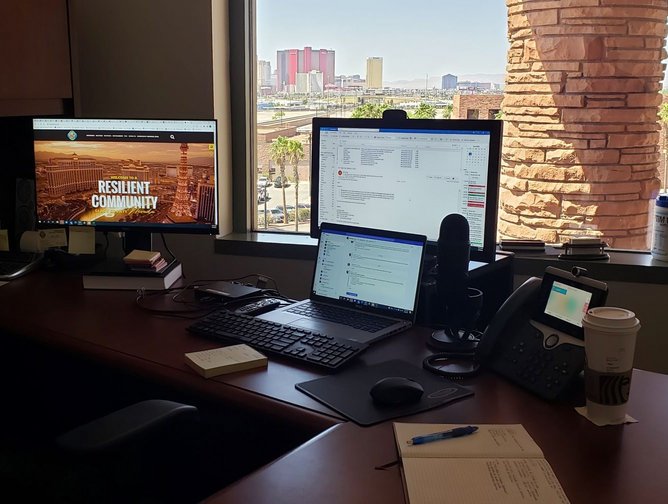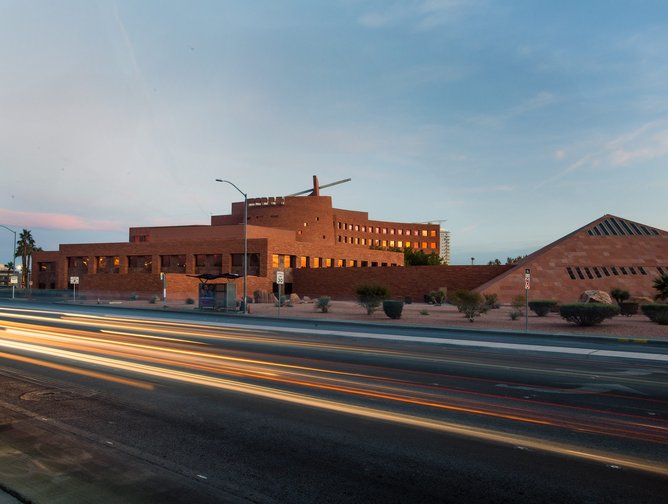Clark County: Effective Public Services through Technology
Clark County, Nevada, is principally known for the flashing lights and fast-living of the Las Vegas Strip, and simultaneously as the intended sports, entertainment, gaming and conference destination of the world.
The ‘brand’ of Clark County is chiefly carried by the Las Vegas Strip – “but we are so much more than that,” says Bob Leek, the county’s Chief Information Officer. “My role encompasses responsibility for delivering all information technology services to the county, so that we can effectively deliver them to the public that falls under our jurisdiction.”
As a consequence of Information Technology, however, the traditional boundaries that delineate this jurisdiction are expanding.
Geographically, Clark County has 2.2 million residents and about 46 million people that visit the county every year. It is also home to the eighth busiest airport in the world, the state's largest public hospital – and is the 11th largest county in the United States in terms of population. Its peer counties are those with cities like Houston, Chicago, San Francisco and New York.
Clark County is unique in that they also provide services which normally fall under the remit of the city or municipality, with over a million people living in unincorporated Clark County.
These public services include fire services, law enforcement, roads and bridges, sewers, parks and recreational planning, permitting and business licensing – services that cities would typically provide.
Bob Leek is a department head amongst 38 departments at Clark County.
“I work with my peers on how they deliver services to the public, and we divide that up into two main objectives,” he says. “The first is to keep all of the information technology, resources and assets (such as uptime and availability, network, devices and operating systems) – everything that people would typically associate with traditional IT related roles – running and humming.”
“But the other objective (which is rapidly growing in local government) is to consider and plan for the future,” he says, “and that means working closely with all departments to identify and understand how they want to improve the delivery of services to the public, and how that can be enabled by technology.”
According to Leek, these objectives are carried out with the underlying intent to create “a great place to work”.
Motivated and fulfilled staff translate into the effective provision of services to Clark County’s public. This recognition is crucial. It belongs to the growing trend of recent years: applying a holistic approach to synthesising the macro and micro ecosystems of wellbeing, as well as the intimate relationship between the wellbeing of the providers of public services with that of the public, who are its ultimate recipients.
Digital Transformation in the light of Diversity and Inclusion
The public in question is composed of a tremendously diverse population, composed of approximately 40% Caucasian, 30% Latino, 12% African American, and 10% Asian , with the full balance of the population covering Native and Indigenous populations, too. “It’s important, therefore, that we support and provide help to this very diverse demographic,” asserts Leek.
Digital transformation at Clark County takes an intergenerational view, having its eye focused firmly on both its present state, as well as the inevitable future composition of the public demographic.
According to Leek, there are five generations – and “a rapidly growing sixth” – of people that live in the county. There's also a general expectation that “in most people's lives, the ability to interact is done digitally”. But ‘most’, of course, does not encompass the entire picture, and Leek is highly aware of this fact.
In the grand global push for the digitalisation of almost every aspect of our lives, many organisations – whether private or public – are prone to overlooking the potential adverse repercussions of such a sweeping overhaul if not approached with equanimity and foresight.
What Leek and Clark County have grasped is the transparent, yet often disregarded point that the move towards digitalisation is one that, in the end, is meant to be fundamentally in the service of people. Any premature, wholesale attempt to digitise public life is, therefore, liable to neglect those people and demographics who are at risk of being alienated due to their inability to interact with digital technologies. This ability may be socio-economic, or it may be generational, but, whatever form it takes, that it is present is undoubtable.
“The expectations of older generations,” says Leek, “dictate that, since they’ve grown up knowing that they could talk to or see someone in a public-service capacity in-person and actually visit a government office in order to meet their needs, it’s important that we develop solutions that cover those expectations, too.”
The choice to access local government services in both digital and ‘analogue’ (or, more correctly, physical forms) must be provided, and Clark County is strongly dedicated to providing these complementary systems of access to public services.
Leek says: “For us, this idea of digital transformation is not about eliminating the option that isn't digital, but about supporting an analogue transaction as well as a digital transaction. In order to do that, we have to completely rethink our workflows and have been making massive strides towards this.”
The Development of Clark County’s Technology Strategic Plan
Clark County’s strategic plan here was first developed a few years ago, and Leek admits that the initial versions were “pretty audacious” in terms of the intent around delivering new technological capabilities.
Initially, it had 10 intentional outcomes, five of which were externally focused and further five of which were focused internally. Over time, however, it became clear that its scope was too ambitious for any organisation to implement at any one time.
Seeing that a more viable plan was needed, Clark County quickly set about transforming the strategic plan that would in turn set in motion the transformation of their technological and, subsequently, their public services landscape. “The latest version of our strategic plan is really focused around three key intentional outcomes,” says Leek.
“One is publicly focused and oriented around both analogue and digital transformation models that support the delivery of services. The second is departmentally focused and looks at how our 10,000 employees are all able to use this technology to deliver services to the public. The third has an employee focus, which emerged out of the COVID-19 emergency response – a recognition that we need to take some time to intentionally concentrate on the employee experience, in addition to what we might call our customer experience.”
These three pillars serve as the basis for Clark County’s technology plan, and it's important to note that the county’s technology strategy is distinct from its IT strategy – which concerns itself with areas such as cloud-based services, mobility and web-based capabilities, and focuses on their network.
“In the end,” says Leek, “all of these strategies and approaches have the essential and ultimate goal of improving the lives of the people in our community.”
Any resident that travels around the county in Southern Nevada might go through the four cities that are in the Metro area, which are the city of Las Vegas, the city of North Las Vegas, the city of Henderson and Boulder City. And, the County supports the needs and residents of rural areas including Mesquite, Laughlin, Primm, and Indian Springs at the edges of the county.
“The relationship that we need to have with our residents,” explains Leek, “has to recognise that any resident travelling around the county is not intuitively going to distinguish local government services from the city's or the county's.”
The relationship that Clark County seeks to have with each of these jurisdictions is based around thinking in the macro-sense – and from a resident-centric point of view – and asking what it is that a resident requires; who it is that’s providing those services; and how they can be made seamless and predictive so that residents can easily gain access to those services.
This seems like an obvious point, but is actually quite innovative in terms of thinking about public services. The traditional model has always been more ‘top-down’ in terms of delivery and access, but Clark County – aided by technological developments – is now moving to the establishment of a more dynamic and interactive public service model, and technology forms its foundation.
Technology as a catalyst for effective public service
There is no aspect of public service in Clark County that doesn't have a technology component associated with it, and so all public services need to be enabled digitally, or through technology, in order to improve the lives of its residents.
As Clark County emerged from what was known as ‘the Covid emergency response’, to the 'new normal' that we now live with, Leek says that the team “spent a lot of time considering the impacted areas of people's lives”.
The ‘Pre-Covid era’ saw a Clark County workforce that was focused on a mix of traditional and innovative thought processes in the delivery of services, but post-Covid, what the county has seen – after suddenly having to move and support thousands of employees to work-from-home setups – is the expectation that the county deliver “noble solutions”.
“We want to innovate and rethink workflows; we want to adopt and develop using agile practices; we want our solutions to be tech-enabled; and we want to ask our employees whether it's easy to do their jobs and, if not, what it is that prevents their jobs from being easily done,” says Leek.
There were several initiatives that the county had on the books for years, such as digital signatures for documents, an initiative that had always been deprioritised in light of other needs. When the pandemic hit, the only way for leaders and their staff to sign documents, for example, was to implement an electronic signature solution. This was the case for both public and private enterprises the world-over. And, in short, that which was shelved for years became a reality in mere weeks due to necessity.
“On that basis,” says Leek, “we now ask ourselves, ‘what does nimble, innovative, smaller, agile, iterative development and service-modelling look like, versus how we would have done things in the past?’.”
The technological foundation of effective public service delivery is one which inevitably requires partnerships, and Clark country’s partnerships are no exception.
Clark County’s core partnerships: T-Mobile and ServiceNow
T-Mobile is one of the key service providers in the Clark County region – a relationship founded on a couple of basic, yet important principles.
One of these is that the two are closely aligned in their values. “Our mission is to deliver services to the public; T-Mobile's mission includes providing access to cellular solutions and the internet – and they are really focused on the opportunity to use those solutions in the way that a subscriber is looking for.”
Furthermore, T-Mobile is a national organisation, and, as Leek says, Clark is “a very large urban and rural county” that is focused on working with “partners that have a national perspective”.
“We have very robust programmes with local organisations as well, but T-Mobile would be a great example of an organisation that we expect to work with because we are one of the largest counties in the US, and those large service providers would of course love to have access to as many subscribers as they could in a market like ours. So strategically we work with T-Mobile by sharing our plans with them concerning where we're going in terms of the services that we're trying to provide - and then we welcome their input to help refine those potential solutions.”
Another of Clark County’s major partners is ServiceNow. The county was an early adopter of ServiceNow and has been a customer for many years.
“They provide some of our most core services when it comes to our IT organisation,” says Leek, “as well as our incident and problem management. Our asset management is also soon going to be done on ServiceNow, too.”
The ServiceNow toolkit really serves as engine for the delivery of Clark County’s IT services, “but in the future – being one of the premier, low-code/no-code solutions really focused on workflows – ServiceNow will be a key platform on which we can build the types of solutions that we need”, according to Leek.
“We take an approach stipulating that, when we're presented with a need, the question we ask ourselves is, 'why can't we do it on ServiceNow?'.”
From eCommerce to eGovernment: inspirations from the private sector
Bob Leek didn't grow up in public services. Soon, it will be his 10th year as a leader of county services, but his background is in retail – working for a company called egghead.com during the dot com era – and then for Kaiser Permanente, one of the largest healthcare companies in the United States, for a further ten years. This movement from digital and gargantuan private companies to public services has endowed him with a perspective that could be greatly beneficial to the delivery of public services.
Orienting himself in this direction, he asks: “What does Kaiser do?”
“Well, it delivers services to a patient. Kaiser's model is all about preventive care, and the question is how they can deliver preventive care so that patients never have to actually go into a hospital or an emergency department. So the mindset was always around what is now called ‘user-centred design’.”
User-centred design tries to optimise the product or service around how users can, want, or need to use the product, preventing users being forced to change their behaviour and expectations to accommodate the product. “Kaiser's entire model is essentially around user-centred design.”
This is where Leek’s background now finds its feet: in the context of a nonprofit and user-centred design principle. There are over 3000 counties in the United States, and Leek’s vision is that Clark County could have a service model that could be scaled down to a county that has far fewer residents.
In local government, there’s a real opportunity to connect from within an organisation to the public in the delivery of services. Other industries have been doing this for years, if not decades.
“When you think about the retail industry”, says Leek, “the online eCommerce capabilities have matured to such an extent that now, most people expect that whatever it is that they need to access, will, through a website, be delivered to their door within an hour or two.
“I'm not sure that people have thought about the local government services sector in the same way as the private sector, but now the availability of technology in local government means that we could really do that.”
In practice, Leek sees that this could manifest in the following manner.
“For example, if a resident has an urgent need, the county’s ability to respond in a way that doesn't start with a phone call or an in-person visit, but instead with texting 'help' to a text short code and having a county service show up within an hour, would be the equivalent of the eCommerce model.”
“What is available now is the technology to pull all of that together, if we just step back and rethink what it is that the public needs from us.”
This approach is truly visionary in terms of access to local government and public services. The principles of supply and demand that serve as the engine for the private sector have, granted, acted as a fundamental stimulus to the development of cutting-edge, almost instantaneous access to products and services – but why shouldn’t this model be applied to the public sector? Bob Leek has grasped this insight and views it as sitting firmly on the horizon, a gateway to the evolution of public services access, which could take it to the next level of civilization in the true definition of the word.
Leek says: “Another example would be, say, if a small business owner is looking to expand their physical footprint in their store; they need permits in order to do that. If those permits are pretty straightforward – such as getting a plumbing, electrical or structural permit, because there's not a lot of complexity in those types of projects – the ability to deliver those permits digitally and swiftly could be achieved, and this possibility is readily available through the technology that exists right now.”
Big investments, big changes, big opportunities
Clark County is presently seeing its sports and resorts industries going through a new wave of investment in building, especially with the recent addition of the Las Vegas Raiders, in addition to the construction and opening of the Allegiant Stadium in 2020. Clark County also has to engage those projects and have supported those industries as well.
But their focus is on the 2.2 million people and the over 150,000 businesses that exist there. “Really, it's about rethinking how to deliver government services on a digital footprint,” says Leek, “and frankly, it's expected by the public.”
“The investments that are now capable of being made, especially through the programmes at both federal and state level – where one of the biggest historical barriers has always been funding – are very promising.
“There are big changes that are taking place now, and the availability of funding to apply to these types of service models is unprecedented. We have this great opportunity where funding is being allocated to create digitised solutions for the delivery of public services. For that to be achieved, a plan is needed (which we have), intent is needed (which we have), and we need to deliver services to the public (which is what we do).
The county has seven main areas of focus for the next 12 to 18 months. These are: the addressing of homelessness, houselessness and providing access to affordable housing; providing high speed, affordable internet access for all residents; public safety, security and privacy; innovation and new technologies like AI and machine learning; data integration and visualisation; and workforce and technology skill improvement.
Bob Leek says, “the present place is an exciting place to be.”






